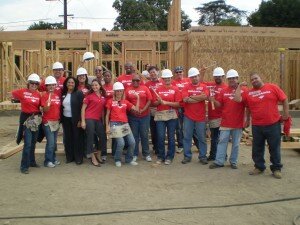 Do you want to create an impact in your community? Do you see a need that isn’t being met and want to act to fix it? Do you want to inspire and move people to act with you?
Do you want to create an impact in your community? Do you see a need that isn’t being met and want to act to fix it? Do you want to inspire and move people to act with you?
Do you know where to start?
Your first step is going to be working with your community to identify the issues that affect it the most. While you may be tempted to simply plan a project without any kind of outside input, your project will have a greater impact if you involve the community.
You may already have a passion for a particular issue, such as education, the environment or the economy. However, a community needs assessment is still an important part of designing a service project. A community assessment can be as simple as taking a walk through your neighborhood or as involved as surveying the whole city where you live.
What’s most important is focusing on the community when you’re trying to identify a need to address through service.
There are a lot of different ways to find a community’s need. You should select one that fits the scope of the volunteer project you’re planning. For a one-day project, you may want to choose an assessment method that doesn’t require a lot of time. For a long term project, devote a little more time to conduct an in-depth assessment to make sure you effectively use your resources.
Some ideas for doing a needs assessment:
 Brainstorming
Brainstorming
Gather volunteers and community members to talk about community issues or needs. As a group, look at the causes and effects of the issue you’re trying to address, and then brainstorm potential projects that can address that issue.
Community Dreams
As you spend time in your community, talk to other members of the community about the kinds of change that they’d like to see happen. What would they change if they had an unlimited pool of resources? What would they do to make that change happen?
Community Walk
Invite members of the community out for a walk through the community. On the walk, ask community members about the changes they’d like to see in their community. Being out in the community can help to highlight the needs that need to be addressed.
Survey
Conduct a formal or informal survey of community members to identify issues or needs. Ask questions like
- What problems do you see in the community?
- What are the most pressing issues in the community right now?
- What types of service projects would be most beneficial for the community?
- List two things you want to change in the community.
Finding out what your community’s needs are is the first step in making change sustainable. If there isn’t community support for your project, all of the work that you’ll put into planning your project won’t have as big of an impact. Learning what a community’s needs are and working to meet them in a way that is meaningful to the community is a great way to insure that your work will be supported after your project is finished.
What did you do to find a community need that you could address? What were your first steps in planning a service project? Let us know in the comments!



 Starting an employee volunteer program shouldn’t happen on whim. While it may seem easy enough to get a group of employees together for a volunteer event, some planning needs to go into your employee volunteer program or it won’t be as successful as it could be.
Starting an employee volunteer program shouldn’t happen on whim. While it may seem easy enough to get a group of employees together for a volunteer event, some planning needs to go into your employee volunteer program or it won’t be as successful as it could be. An organization’s ability to not only survive, but also thrive in the future is directly proportionate to its capacity to learn. People within organizations, both individually and collectively, need to develop the ability to reflect on their work and willingness to uncover, understand, and reconsider the basic assumptions that underlie the work.
An organization’s ability to not only survive, but also thrive in the future is directly proportionate to its capacity to learn. People within organizations, both individually and collectively, need to develop the ability to reflect on their work and willingness to uncover, understand, and reconsider the basic assumptions that underlie the work.
 Writing exciting volunteer position descriptions can be hard, but there are a lot of ways you can make your volunteer positions more exciting. Here are a few more tips to make some awesome (and fun) position descriptions. Your volunteer position descriptions should be as awesome as a Star Wars band.
Writing exciting volunteer position descriptions can be hard, but there are a lot of ways you can make your volunteer positions more exciting. Here are a few more tips to make some awesome (and fun) position descriptions. Your volunteer position descriptions should be as awesome as a Star Wars band. Sure, one of the tips was to have fun with the position descriptions, but it’s important to take a moment to be serious, too. Make sure to include a list of the types of skills you want a volunteer to have, or that you can teach a volunteer, so they can be great volunteers for your organization. Don’t forget to include specific information about how to contact your organization (like a contact person’s name) so they can volunteer.
Sure, one of the tips was to have fun with the position descriptions, but it’s important to take a moment to be serious, too. Make sure to include a list of the types of skills you want a volunteer to have, or that you can teach a volunteer, so they can be great volunteers for your organization. Don’t forget to include specific information about how to contact your organization (like a contact person’s name) so they can volunteer. No matter how well you plan a volunteer event or manage your volunteers, eventually something is going to happen that doesn’t quite go as planned. It’s important to address the problem quickly and professionally and getting back to normal.
No matter how well you plan a volunteer event or manage your volunteers, eventually something is going to happen that doesn’t quite go as planned. It’s important to address the problem quickly and professionally and getting back to normal. Try to understand what has happened that has created some difficulty. Take a moment to reflect on the problem to try to find the root of it. What’s going wrong at the moment needs to be addressed, but there may be a deeper cause of the problem.
Try to understand what has happened that has created some difficulty. Take a moment to reflect on the problem to try to find the root of it. What’s going wrong at the moment needs to be addressed, but there may be a deeper cause of the problem. Once the problem is solved, move on. Try not to dwell on the problem once it’s solved. Don’t keep rolling the situation around in your head, it will only make you anxious and stressed.
Once the problem is solved, move on. Try not to dwell on the problem once it’s solved. Don’t keep rolling the situation around in your head, it will only make you anxious and stressed.

 Volunteers benefit from volunteering, whether it’s from a closer peer-relationship with teachers and staff at the school or by building positive relationships with students. Volunteers benefit from their work with schools through:
Volunteers benefit from volunteering, whether it’s from a closer peer-relationship with teachers and staff at the school or by building positive relationships with students. Volunteers benefit from their work with schools through:
